层次化空心CoxNi3-xS4的控制合成,以提高速率性能和良好的循环稳定性
IF 3.5
3区 化学
Q2 CHEMISTRY, INORGANIC & NUCLEAR
引用次数: 0
摘要
电极材料的战略性设计和改进对于能量存储和转换设备的有效性至关重要。在此,我们通过水热法和气相硫化法相结合的工艺,成功合成了一系列 CoxNi3-xS4 空心微球。这些微球由相互连接的纳米片组成,表面均匀分布着纳米颗粒。这种独特的分层结构整合了一维、二维和三维元素,从而有利于暴露更多的活性位点,增强电解质与活性位点之间的相互作用,加速载流子传输,并缓解循环过程中的体积膨胀。具体来说,改变摩尔比会产生不同的纳米片厚度,钴含量越高,纳米片越厚,而镍含量越高,纳米片越薄。优化后的(Co1Ni2)S4 电极材料在 1 A g-1 电流条件下的比容量达到了惊人的 204.9 mAh g-1(1639 F g-1),同时还具有出色的速率能力(电流增加 20 倍后仍能保持 80.5%)和卓越的循环稳定性(循环 15,000 次后仍能保持 96% 的初始容量)。当(Co1Ni2)S4//AC配置与源自莲花花粉的活性炭(AC)配对形成超级电容器装置时,在800 W kg-1的条件下,能量密度达到66.5 Wh kg-1。值得注意的是,即使经过 30,000 次循环,该装置仍能保持其初始容量的 98%,同时库仑效率保持在 100%。这项研究为精确制造具有更强电化学特性的先进双金属硫化物提供了一种令人鼓舞的方法,从而促进了它们在储能技术中的更广泛应用。本文章由计算机程序翻译,如有差异,请以英文原文为准。
Controlled Synthesis of Hierarchical Hollow CoxNi3-xS4 towards Enhanced Rate Capability and Excellent Cycling Stability
The strategic design and advancement of electrode materials are crucial for the effectiveness of energy storage and conversion devices. Herein, we successfully synthesized a series of CoxNi3-xS4 hollow microspheres through a combined hydrothermal and vapor-phase sulfidation process. These microspheres are composed of interlinked nanosheets featuring uniformly distributed nanoparticles on their surfaces. This distinctive hierarchical structure integrates one-dimensional, two-dimensional and three-dimensional elements, thereby facilitating the exposure of more active sites, enhancing electrolyte-active site interactions, accelerating carrier transport, and mitigating volume expansion during cycling. Specifically, varying the molar ratios results in different nanosheet thicknesses, with higher cobalt content leading to thicker nanosheets and higher nickel content producing thinner ones. The optimized (Co1Ni2)S4 electrode material demonstrates an impressive specific capacity of 204.9 mAh g-1 (1639 F g-1) at 1 A g-1, along with remarkable rate capability (holding 80.5% when the current is increased 20 times) and exceptional cycling stability (maintaining 96% of its initial capacity after 15,000 cycles). When paired with lotus pollen-derived activated carbon (AC) to form a supercapacitor device, the (Co1Ni2)S4//AC configuration reaches an energy density of 66.5 Wh kg-1 at 800 W kg-1. Notably, even after 30,000 cycles, the device retains an outstanding 98% of its initial capacity while sustaining 100% Coulombic efficiency. This study presents an encouraging method for the precise fabrication of advanced bimetallic sulfides with enhanced electrochemical characteristics, facilitating their broader application in energy storage technologies.
求助全文
通过发布文献求助,成功后即可免费获取论文全文。
去求助
来源期刊

Dalton Transactions
化学-无机化学与核化学
CiteScore
6.60
自引率
7.50%
发文量
1832
审稿时长
1.5 months
期刊介绍:
Dalton Transactions is a journal for all areas of inorganic chemistry, which encompasses the organometallic, bioinorganic and materials chemistry of the elements, with applications including synthesis, catalysis, energy conversion/storage, electrical devices and medicine. Dalton Transactions welcomes high-quality, original submissions in all of these areas and more, where the advancement of knowledge in inorganic chemistry is significant.
 求助内容:
求助内容: 应助结果提醒方式:
应助结果提醒方式:


